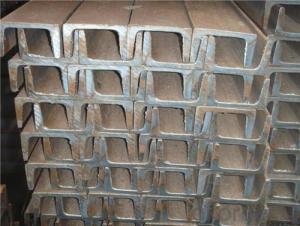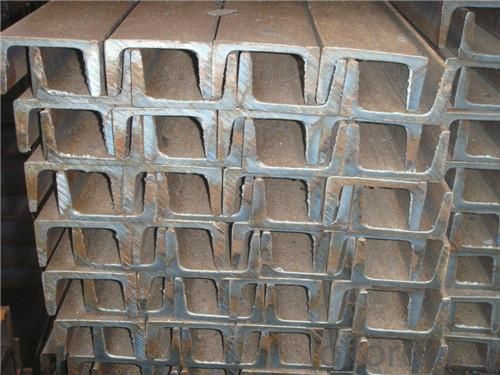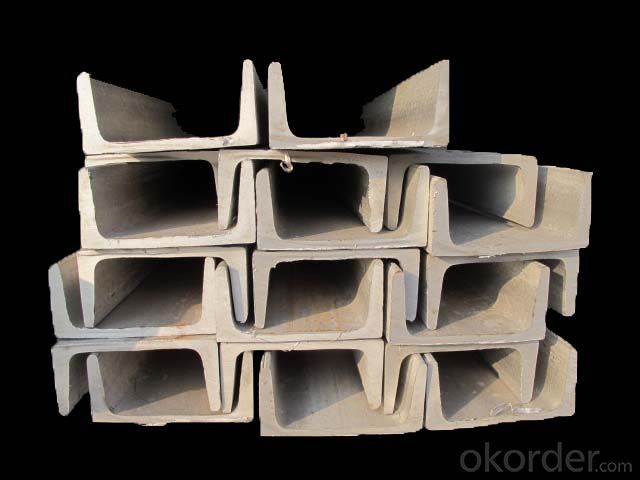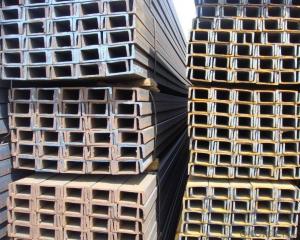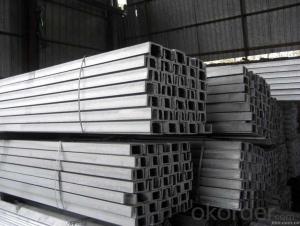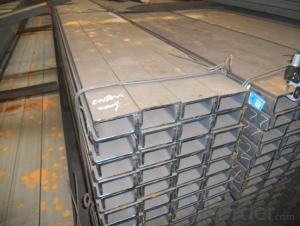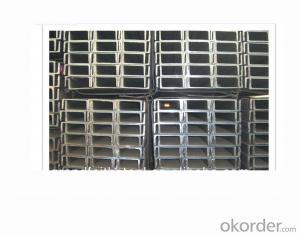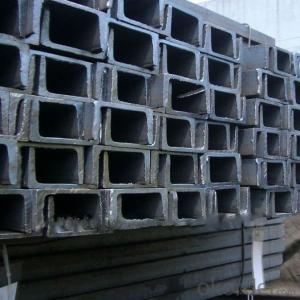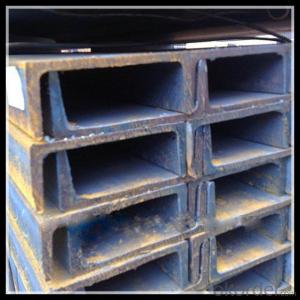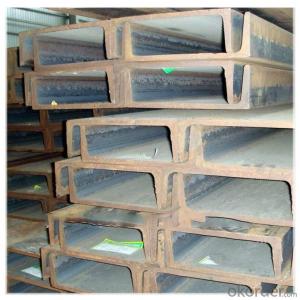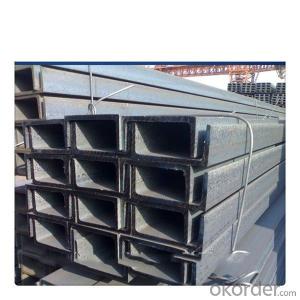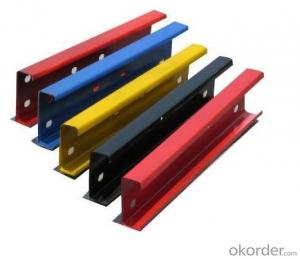Height 85mm the Thickness 8mm Surface and Length: according to the requirements of Channel Steel
- Loading Port:
- Qingdao
- Payment Terms:
- TT OR LC
- Min Order Qty:
- 15 m.t.
- Supply Capability:
- 50000 m.t./month
OKorder Service Pledge
OKorder Financial Service
You Might Also Like
1、the details information of our Channel Steel
1)the ordinary model
Height: | 60-400mm |
Thickness: | 9-14.5mm |
Surface: | according to the customers’ requirements |
Length: | As customers’ requirements |
Size: | 90*37*4.5mm--400*104*14.5 mm . |
Punch: | Can be punched as customer's drawing |
Material: | Q195/Q235/ Q215/Q345/SS400/S235JR, A36,SS400,SS540 ASTM A36 and so on |
2)the light model
Height: | 60-400mm |
Thickness: | 6.4-8.0mm |
Surface: | Painted or Galvanized;according to the customers’ requirements |
Length: | As customers’ requirements |
Size: | 50*32*4.4mm--400*115*8.0mm . |
Punch: | Can be punched as customer's drawing |
Material: | Q195/Q235/ Q215/Q345/SS400/S235JR, A36,SS400,SS540 ASTM A36 and so on |
2、the Product Advantage
1) We can design the channel steel according to customers’requirements
2) We can manufacture under complete quality control system---ISO9001&SGS
3) We can installed with instruction of experienced engineers
4) Easy to assemble and dismantle
5) Eco-friendly material: can be used for several times and can be recycled
6) Shorter construction period, longer using time
7) High strength and stiffness, high weight bearing
3、why choose us ?Product Advantage
1)The channel steel quality is prime quality
2)Our price is competitive price with our competitor
3)We provide the professional service
4)Prompt delivery & Seaworthy packing
5)Mill Test Certificate
4、why choose us ?
Company Information
which is one of the largest manufacturing bases of Steel Channel in northern China. We are a company that is specialized in producing Stainless Steel Channel、Prime Stainless Steel Channels and so on.
With years of development, our company won the trust and excellent reputation of customers for the quality of our products and sincere service, as well as foreign users of the community.
Please contact me if you are interested in our products and I will try my best to offer you the best goods and service.
- Q: Are steel channels suitable for heavy machinery installations?
- Indeed, heavy machinery installations can be properly accommodated by steel channels. Construction and engineering projects frequently incorporate steel channels because of their robustness, longevity, and ability to bear loads. They offer outstanding support and stability for heavy machinery, thereby becoming an optimal selection for installations necessitating a sturdy and secure base. Moreover, steel channels possess the capability to endure substantial loads, vibrations, and impact, guaranteeing the safety and effectiveness of the machinery. Their adaptability and capacity to be tailored to specific requirements also contribute to their popularity in heavy machinery installations. All in all, steel channels prove to be a dependable and appropriate choice for supporting heavy machinery across various industries.
- Q: What are the factors that affect the strength of steel channels?
- The factors that affect the strength of steel channels include the alloy composition, heat treatment, dimensions (such as width, height, and thickness), shape, and the presence of any defects or imperfections in the material. Additionally, the manufacturing process, including the quality of the steel and any surface treatments or coatings, can also impact the strength of steel channels.
- Q: What are the different testing methods for steel channels?
- There are several testing methods for steel channels, including visual inspection, dimensional measurement, ultrasonic testing, magnetic particle testing, and load testing. Visual inspection involves examining the surface of the channel for any visible defects or irregularities. Dimensional measurement ensures that the channel meets the specified dimensions. Ultrasonic testing uses high-frequency sound waves to detect internal defects such as cracks or voids. Magnetic particle testing utilizes magnetic fields and iron particles to identify surface cracks or discontinuities. Load testing involves applying a known load to the channel to evaluate its strength and deformation characteristics.
- Q: How do steel channels compare to other structural shapes?
- Steel channels are a structural shape that is versatile and widely used, offering various advantages compared to other shapes. One of the main benefits of steel channels is their high ratio of strength to weight. Their shape provides excellent support and load-bearing capacity, enabling the construction of strong and durable structures. In contrast to I-beams or angles, steel channels have a unique cross-section in the shape of a C, which provides greater resistance to bending. This makes them particularly suitable for applications where bending or torsional forces are present, ensuring the stability and integrity of the structure. Furthermore, steel channels come in a wide range of sizes and configurations, making them highly adaptable to different construction needs. They can be easily customized and cut to specific lengths, allowing for precise installation and minimizing waste. This versatility makes steel channels a popular choice in industries such as construction, manufacturing, and engineering. Another advantage of steel channels is their cost-effectiveness. Steel is a comparatively affordable material, and using steel channels efficiently in construction projects can optimize costs without compromising structural integrity. Additionally, steel channels have excellent corrosion resistance, extending their lifespan and reducing maintenance and replacement expenses. To summarize, steel channels offer numerous advantages over other structural shapes. Their high strength-to-weight ratio, resistance to bending, adaptability, and cost-effectiveness make them a reliable choice for various construction applications.
- Q: What are the different methods for protecting steel channels from corrosion?
- There are several methods for protecting steel channels from corrosion. One common approach is applying a protective coating, such as paint or powder coating, which creates a barrier between the steel and the environment. Another method is galvanizing, where a layer of zinc is applied to the steel surface through hot-dip or electroplating, providing corrosion resistance. Additionally, using stainless steel channels, which contain a high percentage of chromium, can offer excellent corrosion resistance. Regular maintenance, such as cleaning and removing accumulated debris or moisture, can also help prevent corrosion on steel channels.
- Q: Can steel channels be used for overhead garage doors?
- Yes, steel channels can be used for overhead garage doors. Steel channels are commonly used in the construction of overhead garage doors due to their strength, durability, and ability to withstand heavy loads.
- Q: How do you mark the types of steel such as channel, I-beam and so on in the document?
- In the document mark "channel", "I-beam" and other steel symbols, the input method of small keyboard, right-click the Greek character mother.Section steel is a strip steel with definite section shape and size. It is one of the four big kinds of steel (plate, tube, mould, wire). According to the section shape, the section steel is divided into simple section steel and complex section steel (deformed steel). The former refers to the steel, round steel, flat steel, angle steel, six angle steel; the latter refers to the I-beam, channel steel, steel, steel, steel frame bending etc.
- Q: What are the common methods of joining steel channels together?
- Common methods of joining steel channels together include welding, bolting, riveting, and using adhesive or epoxy. Welding is a popular method that involves melting the edges of the steel channels and fusing them together. Bolting involves connecting the channels using bolts and nuts. Riveting involves inserting rivets into pre-drilled holes and deforming them to hold the channels together. Adhesive or epoxy can also be used to bond the channels together, providing a strong and durable connection.
- Q: Can steel channels be used in cold storage facilities?
- Yes, steel channels can be used in cold storage facilities. Steel is a strong and durable material that can withstand the low temperatures and provide structural support for the storage facility. It is commonly used in the construction of cold storage buildings due to its resistance to corrosion and ability to maintain stability in cold environments.
- Q: How do steel channels compare to other structural materials like wood or concrete?
- Steel channels have several advantages over other structural materials like wood or concrete. Firstly, steel channels have a higher strength-to-weight ratio, meaning they can support greater loads with less material. This makes them more efficient and cost-effective in construction projects. Additionally, steel channels are more durable and resistant to rot, pests, and fire compared to wood. They also offer better dimensional stability, allowing for precise construction and reducing the risk of warping or shrinking. Compared to concrete, steel channels offer greater flexibility in design and can be easily modified or reconfigured if needed. Moreover, steel channels have a longer lifespan and require less maintenance than wood or concrete. Overall, steel channels are a superior structural material due to their strength, durability, versatility, and longevity.
Send your message to us
Height 85mm the Thickness 8mm Surface and Length: according to the requirements of Channel Steel
- Loading Port:
- Qingdao
- Payment Terms:
- TT OR LC
- Min Order Qty:
- 15 m.t.
- Supply Capability:
- 50000 m.t./month
OKorder Service Pledge
OKorder Financial Service
Similar products
Hot products
Hot Searches
Related keywords
